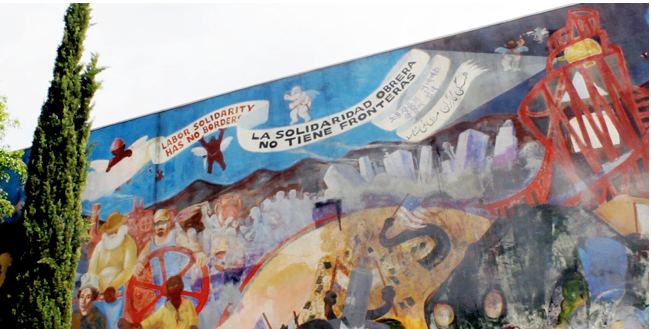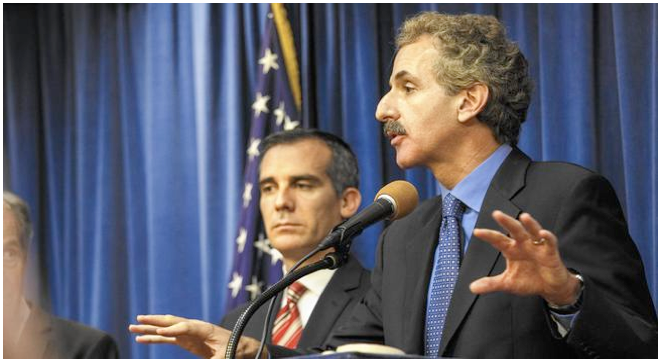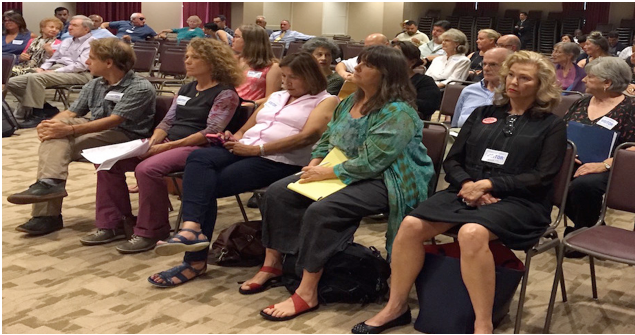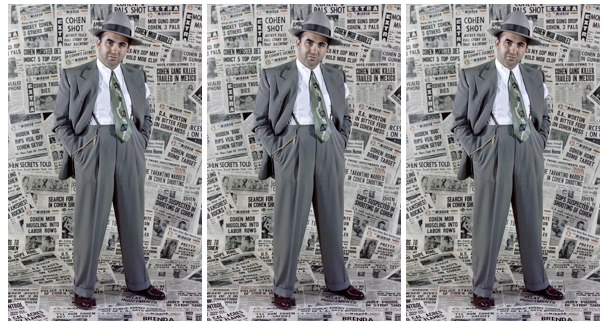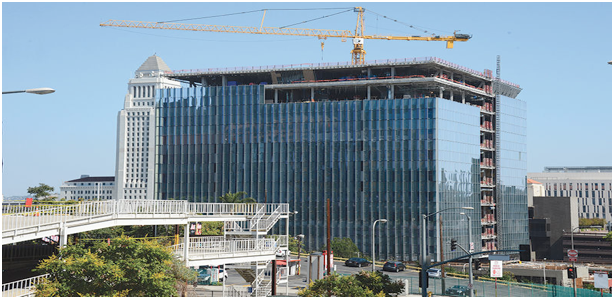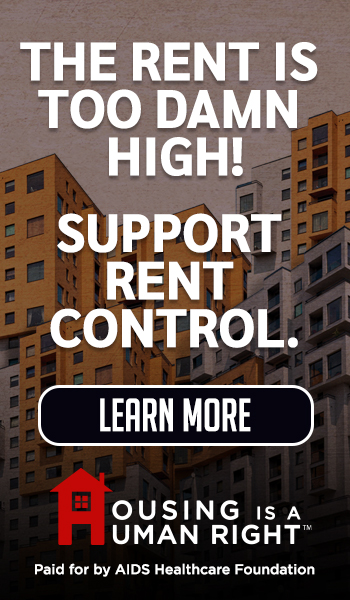Silver Lake Reservoir: The Plug has been Pulled but Anxiety Mounts
DEEGAN ON LA-It sounds romantic and dreamy: the “Meadow,” the “Knoll,” the “Eucalyptus Grove,” starry nights, family fun. A destination with enhancements, a beach, an esplanade, a park, a picnic on blankets, maybe a plunge pool for swimming. It also sounds like a marketing pitch. But some are looking forward to this possible vision of Silver Lake Reservoir.
Others see, and want, a tranquil lake to gaze at from the hillside at sunset, birds dipping their beaks, children feeding the ducks, great blue herons being sustained by the Pacific Flyway, a pastoral vision in the center of urban mass. Like nature: a release, a palliative, an escape.
These opposing viewpoints are held by two organizations that were launched in the spring of 2016, when it became apparent that a huge vacuum may exist in what to do once the DWP has completed repairs at Silver Lake Reservoir and adjacent Ivanhoe Reservoir.
One option is refilling the reservoir and beautifying afterwards, as Refill Silver Lake Now is asking. The group describes itself as “a dedicated group of people advocating for the prompt refilling of the Silver Lake Reservoir (Historic-Cultural Monument 422), home to many species of wildlife and critical nesting grounds for the legally protected Blue Heron. The Reservoir is not only a crucial spot on the Pacific Flyway for migrating waterfowl, but an essential body of water for the LA County Firefighters in battling blazes in the area, including Griffith Park. In short, it is the heart and soul of the 43,000 people and countless wildlife that call Silver Lake their home.”
The other option being promoted is to create a “destination” (including a water feature.) That is the plan of Silver Lake Forward which calls itself “your new neighborhood action group” consisting of “conservation advocates, architects, activists, and entertainment and media industry executives.” They have an agenda and some political connections to try and get what they want -- far more, it sounds, than what the community is comfortable with.
Some residents say they have been made to feel apprehensive recently by Silver Lake Forward that was launched in April by Catherine Geanuracos. It’s a successor group to the Geanuracos-led Swim Silver Lake, launched in 2014, that invited the community to embrace Geanuracos’ vision and be “part of the transformation of our neighborhood,” by turning the Silver Lake Reservoir into the "Silver Lake Plunge." Having a beach club replace the Ivanhoe Reservoir, within the Silver Lake Reservoir complex, was a concept that attracted very little interest and was dropped. However, Geanuracos has not given up on her attempts to gentrify Silver Lake Reservoir, even though the community has not acquiesced to those desires.
A dry lake can become a fertile playground for change -- another thing that has the community wondering. When will the water return? A spokesperson for the Los Angeles Department of Water and Power, owner and operator of the reservoir, told CityWatch that "we are still targeting May for the start of refilling of the reservoir. We expect it to take about a month to fully cover the entire bottom and then it will continue to rise, but it will take time."
This suggests filling the reservoir now and then beautifying or enhancing the surrounding area, if that is what is decided by the community and approved by David Ryu (CD4) and Mitch O’Farrell (CD13), the two Councilmembers that share jurisdiction over the reservoir. That’s what Refill Silver Lake Now wants.
Ninety-six acres of open space in the middle of the city, without the water that should be there, is a tempting sight and creates anxiety about the “what-ifs?” The space is huge -- it could fit 500 single family homes, to give some sense of proportion to it. Some describe the possibilities of what can be done with Silver Lake Reservoir as “a marketplace of ideas” but residents may be more calling it “a community.” Silver Lake residents don’t want the reservoir turned into a laboratory of ideas for reimagining what has been a pretty good thing for the past 110 years -- a beautiful lake in the middle of the city. They worry about the stresses of development that a “destination” brings, change that would alter the character of the serene setting, adding traffic and other impacts to the neighborhood.
This may be something the community did not want to begin with.
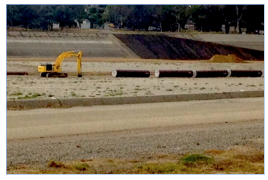 Silver Lake Reservoir and the adjacent Ivanhoe Reservoir are now empty. (see photo left) But the community is full of questions about the future of this complex. They fear they would face the prospect of a less bucolic lake with the introduction of asphalt for parking lots and other amenities -- like restrooms, hot dog stands and food trucks – all bringing congestion, chlorine, and other unknown impacts.
Silver Lake Reservoir and the adjacent Ivanhoe Reservoir are now empty. (see photo left) But the community is full of questions about the future of this complex. They fear they would face the prospect of a less bucolic lake with the introduction of asphalt for parking lots and other amenities -- like restrooms, hot dog stands and food trucks – all bringing congestion, chlorine, and other unknown impacts.
The sooner the water is returned to the reservoir the better, as that will set some boundaries for development. “There is a limited amount of additional space that could be opened to the public, and the DWP has not yet determined how much space it might need for its more limited operations once it is decommissioned as a drinking water reservoir,” said David Keitel, President of the Silver Lake Conservancy, who added, “There are now two public park spaces on the property - a multi-use park and recreation center at the south end of the property and the newer Meadow Park on the east side.”
Another source of anxiety is, will DWP follow through and refill the reservoir on schedule? Or will Silver Lake Forward’s political connections to Councilmember O’Farrell and the Englander, Knabe & Allen lobbying firm help them pre-empt the DWP’s plans, delay the refilling of the reservoir, and instead, start preparations for their “destination?”
The statement by DWP to CityWatch seems to indicate, for now, that the answer is “yes” -- the reservoir will be refilled in May. However, two city councilmembers and the opposing agendas of community groups must get into alignment.
At least for now, “There is no plan to substitute a park for the water. The DWP has publicly stated more than once that to fill the space would take many years of all-day truck trips. To do so would essentially destroy Los Angeles City Historic-Cultural Landmark No. 402, designated in 1989,” said David Keitel of the Silver Lake Reservoirs Conservancy.
“There is a variety of feelings within the community about what should be done with the land surrounding the reservoir once it has been refilled and for the long run, including improved/increased public access, the preservation of the natural environment and general property maintenance,” Keitel continued.
“There are now two public park spaces on the property - a multi-use park and recreation center at the south end of the property and the newer Meadow Park on the east side. There is a limited amount of additional space that could be opened to the public, and the DWP has not yet determined how much space it might need for its more limited operations once it is decommissioned as a drinking water reservoir,” said Keitel.
The Silver Lake Neighborhood Council has not yet had hearings or taken a position, but others in the community have. Refill Silver Lake Now Co-Founder Jill Cordes points out, “We don’t need to be a world class destination—this is not Chicago and the Great Lakes lakefront. We have a ton of destinations in LA. We don't need, nor want, the reservoir itself turned into something other than the beautiful body of water that it has traditionally been. If more park space is wanted around the perimeter we are absolutely open to discussing that. And remember we already have green space, including a soccer field, playground, basketball court and the Meadow. And Echo Park and Griffith Park are a mile away. What’s wrong with wanting a respite in the middle of the city?”
Community feedback, in an empirical and non-emotional format, is being prepared through a survey by the Silver Lake Reservoirs Conservancy, and should help provide Councilmember Ryu, a strong advocate of hearing what the community has to say before making a decision, with some relevant facts.
Conservancy President Keitel shared a preview of their current survey and what is being indicated from the results, telling CityWatch: “The Reservoirs Conservancy has consistently surveyed the resident and user communities about their desires and concerns surrounding the reservoir property, especially following the approval of the Master Plan by the DWP in 2000. SLRC commissioned its most comprehensive survey in 2016, sent to a random sample of 3,400 residential addresses within the Silver Lake Neighborhood Council boundaries.
“While the 800+ responses are still being analyzed for inclusion in a published report, the most highly-rated attribute has been the water, i.e.: maintaining water in the reservoir space. The survey does not address specific proposals by Silver Lake Forward or Refill Silver Lake Now, because it was administered before either of those recently formed groups existed. But the community clearly expressed its appreciation of the public space as a respite, an oasis and a natural environment - and expressed concerns about it being overly developed or commercialized.”
There’s a lot at stake here, including a sense of unwanted change, and a resistance to a repurposing of Silver Lake Reservoir that feels like it’s being forced onto the community. Public feedback and community engagement, like the Conservancy’s survey and the series of community meetings that are being hosted by Councilmembers Ryu (CD4) and O’Farrell (CD13), may help to clarify the anxieties many in the community are feeling about what going forward at Silver Lake really means.
(Tim Deegan is a long-time resident and community leader in the Miracle Mile, who has served as board chair at the Mid City West Community Council and on the board of the Miracle Mile Civic Coalition. Tim can be reached at [email protected].) Edited for CityWatch by Linda Abrams.


